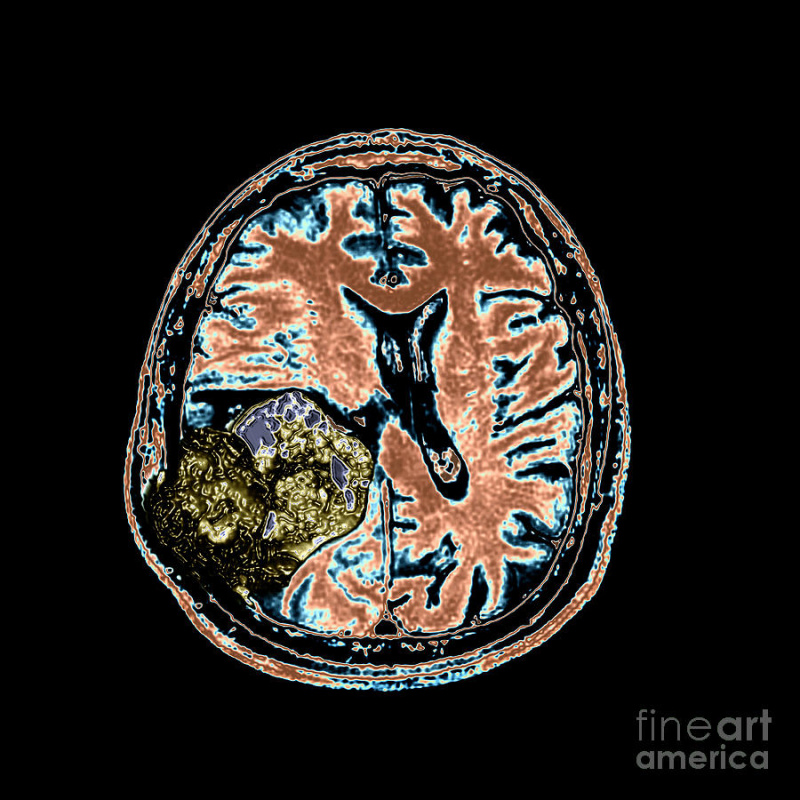What is Glioblastoma?
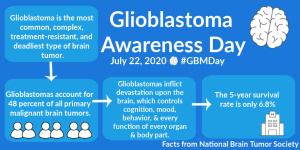 Glioblastoma (GBM) is a fast-growing and aggressive malignant brain tumor. It is a very invasive form of cancer which means it has one of the worst survival rates across all types of cancer. GBM accounts for about 50% of all malignant cancers and the 5-year survival rate is around 6%. It is also estimated that almost 10,000 Americans will succumb to GBM every single year.
Glioblastoma (GBM) is a fast-growing and aggressive malignant brain tumor. It is a very invasive form of cancer which means it has one of the worst survival rates across all types of cancer. GBM accounts for about 50% of all malignant cancers and the 5-year survival rate is around 6%. It is also estimated that almost 10,000 Americans will succumb to GBM every single year.
The symptoms of GBM can include things like headaches that keep getting worse, seizures, nausea, changes in personality, weakness in one side of body, memory loss and speech difficulty. These symptoms can be seen in MANY other diseases, which makes GBM hard to discover and diagnose. The median amount of time before discovery of the tumor is around 330 days, which allows a lot of time for the tumor to grow to nearby cells of the brain.
Subtypes of GBM?
There are four subtypes of GBM that have been discovered and researched.
- Classical
- Over expression of epidermal growth factor receptors and responds best to aggressive treatment.
- Mesenchymal
- Over expression of regulatory components of MAPK and PI3K pathways. Responds best to aggressive treatment.
- Proneural
- Occurs in younger patients and has an over expression on chromosome 4q12. Less responsive to aggressive treatment, but has longer survival time.
- Neural
- No obvious pattern of over expression or mutation. Worst survival rate and no improvement with aggressive treatment.
What is Going Wrong?
MAPK Pathway: 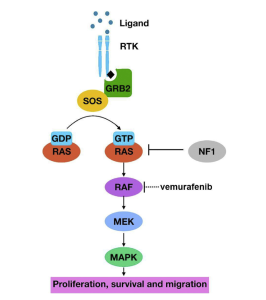
- This pathway is activated by a ligand binding to its receptor tyrosine kinase (RTK) which results in a cascade of activation and phosphorylation. RAS activates RAF which activates MEK which activates ERK/MAPK. In GBM, NF1 is being over expressed which is inhibited the activation of RAS, which stops the activation of the molecules after that.
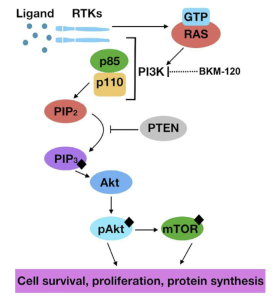 PI3K Pathway:
PI3K Pathway:
- This pathway is activated by a ligand binding to its receptor tyrosine kinase (RTK) which results in a cascade of activation and phosphorylation. PI3K is recruited to the RTK by the p85 subunit which then activates another subunit p110. The p110 subunit converts PIP2 to PIP3, and PIP3 activates AKT which then activates mTOR, promoting cell survival. In GBM, PTEN inhibits the conversion of PIP2 to PIP3, which stops the activation after that.
cAMP Pathway: 
- This pathway is activated by aa ligand binding to G-Protein Coupled Receptors (GPCR). Adenylyl Cyclase converts ATP to cAMP which in turn activates PKA to inhibit tumors. In GBM, PDE is inhibiting this pathway meaning it is under expressed, which results in tumor growth.
There are three different pathways involved in GBM, which makes treating it extremely difficult. These pathways are over and under expressed so finding the ‘sweet spot’ for each pathway is a difficult task. These pathways can also cross over into each other adding more confusion when trying to treat GBM.
GBM Treatment:
Because of the complexity of GBM, finding the proper treatment is just as complex. Treatment options include surgery, radiation therapy, chemotherapy, and antibody therapy.
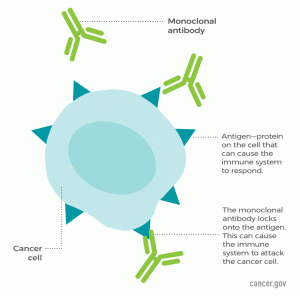 Antibody therapy uses the immune system to help attack cancer cells. Monoclonal antibodies are made in the lab to mimic the bodies natural antibodies. They are infused into the body and are made to attack cancer cells, disrupt the cell membrane of cancer cells, and help T-cells kill cancer cells.
Antibody therapy uses the immune system to help attack cancer cells. Monoclonal antibodies are made in the lab to mimic the bodies natural antibodies. They are infused into the body and are made to attack cancer cells, disrupt the cell membrane of cancer cells, and help T-cells kill cancer cells. 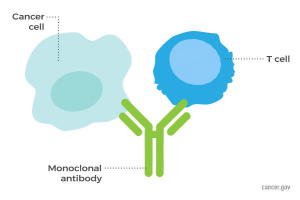
While there are many treatment options to choose from when dealing with GBM, it can can cost a lot of money as well as take an emotional and physical toll on the body. There are many natural ways to try and treat cancer without having to spend most of the time in a hospital bed. Things such as acupuncture, exercise, meditation, cognitive behavior therapy, and music therapies are just a few ways to naturally treat cancer. It is important for the person diagnosed with these types of diseases to consider the ways they want to spend their limited amount of days. Some people may want to try every medical advancement to treat themselves while others may want to find natural ways to spend the rest of their days at peace with themselves. Either way, it is important to understand the statistics of GBM, what is happening in the body, and the options for treatment.
References:
braintumor.org/…ss-day/about-glioblastoma
pubmed.ncbi.nlm.nih.gov/29727799
mayoclinic.org/…glioblastoma/cdc-20350148
cancer.gov/…therapy/monoclonal-antibodies
https://doi.org/10.1016/j.cellsig.2019.01.011
